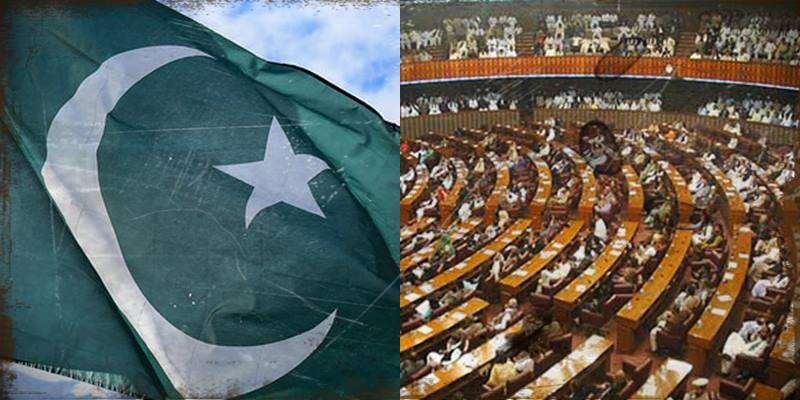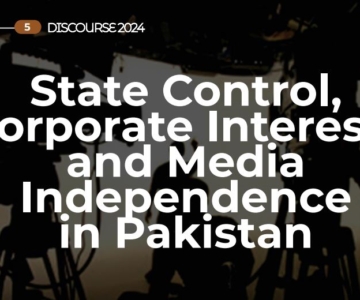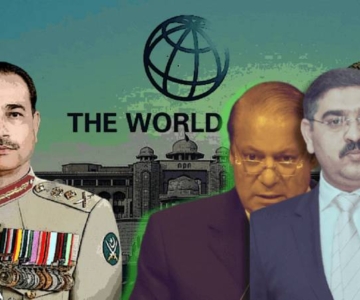Published by The News, Pakistan
If the parliament and judiciary want to continue exercising their newfound powers, they have no option but to act strictly within the framework of the Pakistani Constitution
Pakistan is a surreal country. Only here we have long, protracted struggles for democracy and only here we are almost always ready to scuttle democracy. Perhaps Iskander Mirza was not all too wrong while making the assessment that democracy does not suit the genius of our people. An added qualification is that it does not suit the genius of the elites, in particular the unelected institutions of the state.
There is now a clear and present danger that the judicial review of the 18th Amendment will lead to a potential clash of the key organs of the state: the legislature and the judiciary. Pundits have also predicted that if such a situation arises, then a logjam will benefit the third force – Pakistan’s well organized formal institution, which is readily available to undertake crisis management. Perhaps such fears are slightly exaggerated and misplaced. But the reality is that Pakistani history teaches us some interesting though unsavoury lessons.
Curse of history
The Constitution of 1956 was drafted, almost after a decade of the new country’s formation, as the elites were not interested in changing the colonial structure of the state and its institutions. After much negotiation and a bit of arm-twisting, parity between the Eastern and the Western wings was achieved and finalise the basic law. However, the 1956 Constitution could not be enforced let alone implemented, as new elections were a risk for the national security establishment, which took charge of the country in 1958. The second moment arrived in 1970, when a political consensus arrived through election with divisive results, was once again scuttled by the unelected institutions and the West Pakistani elites. The results were tragic. 1977 was a third moment when the Bhutto administration and PNA movement agreed on a workable package for the future course of politics in the country. Even before this accord could reach the public domain, the Islamo-fascist General took the reins of power and thwarted the political consensus. There is a clear lesson here: a political consensus – wide-ranging, legitimate and inclusive – is a threat to the post-colonial state and the inherent contradictions of the Pakistani polity come into play the moment such compacts are arrived at.
18th Amendment
No constitutional amendment and that too in a fractured and bruised country like Pakistan, can be perfect. Yet the erstwhile enemies, the Pakistan People’s Party and the Pakistan Muslim League (Nawaz), along with a host of regional players, such as the Awami National Party, the Muttahida Qaumi Movement and the Jamiat-e-Ulema-e-Islam, deliberated for several months and agreed on a consensus formula. The allegations that such a deliberation took place within in-camera sessions was not representative, is simple hogwash. Across the globe, this is how political parties work, and not all divisive proceedings are made public for the legitimacy of such a process could easily be thwarted. This is especially true in Pakistan, where unelected, unrepresentative institutions are far more powerful than the operators of a fragile democracy. Public views were invited through national advertisements and all sorts of proposals were considered by the Raza Rabbani constitutional reform committee. The outcomes of such deliberations were speedily ratified by the two houses of parliament, which represent the entire spectrum of the Pakistani federation, and any attempt to undo this development would tantamount to nullifying the popular will.
What is the problem with the 18th Amendment? First of all, it substantially alters the structure of the post-colonial state by undermining the centre and its overgrown powers and functions through abolition of the Concurrent List. Second, it restores the original democratic ideal of Jinnah – a parliamentary framework, albeit it makes little headway on the “secular” portion of the Pakistan project. Third, it radically alters the way judges have been appointed in this country through a club of networks, affiliations, blood and marriage relationships, and above all, connection with the all-powerful executive. An inclusive commission with a majority of judges aims to distribute and dilute the discretionary part of the appointment process. Fourth, the fundamental rights of basic education and freedom of information open up immense possibilities for the concept of citizenship. As has been noted by many political scientists and writers such as Partha Chatterjee, the post-colonial state maintains the fragile association of the poor with the notion of citizenship by not declaring basic entitlements as rights. Education and information are two such powerful concepts. Last, the return of the powers to appoint army chiefs has rightfully gone to the head of the elected executive, i.e. the Prime Minister and the indirectly elected President has been relegated to a figurehead position.
The imminent clash theory
Within hours of the enactment of the amendment, a storm erupted within sections of the media and a section of the lawyers’ community about the alleged distortion of the “basic structure” of the constitution. The “basic structure” theory has emanated from our maligned neighbour, India, where the courts struck down amendments enacted during Indira Gandhi’s regime by labeling them as contrary to the basic structure of the Constitution. First of all, this borrowed imposition from a country which the Pakistani establishment loves to hate, is disingenuous, because our courts have ruled different things at different times, thereby denying a consensus on the basic structure theory, with respect to Pakistan. The most vocal opponent of the 18th amendment happens to be none other than the framer of the 1973 Constitution, Abdul Hafeez Peerzada, who has been making wild observation left, right and centre on how the constitutional amendment is undermining the original principles of the 1973 constitution.
Before we come to the technicalities of Mr. Peerzada’s position, it should be remembered that only a few months ago, Mr. Peerzada, admittedly the finest of legal brains in Pakistan, and an avowedly secular politician of yore, was arguing in favour of the Islamic provisions of the Constitution while indirectly attacking the immunity enjoyed by the President under Article 248. Perhaps Mr. Peerzada has also changed over the decades, for his express admission, Article 2A, which makes the Objectives Resolution an operative part of the Constitution, was legitimate. Article 2A was inserted by a brutal military dictator, who not only abrogated the 1973 Constitution and violated its basic features through the 8th Amendment, but also killed Mr. Peerzada’s celebrated benefactor, Zulfikar Ali Bhutto. The politics of Mr. Peerzada’s position is, therefore, deeply disturbing.
Even on technical grounds, a five-member judgment of the Supreme Court (Pakistan Lawyers’ Forum vs. Government of Pakistan, PLD 2005 SC 719) held that “this court does not have the jurisdiction to strike down provisions of the Constitution on substantive grounds”. Similarly, there are several other references which confirm the view that the Supreme Court does not enjoy the power to strike down a constitutional amendment. Mr. Justice Ajmal Mian’s remarks in a judgment in Abdul Mujeeb Peerzada’s case, PLD 1990 Kar.9 are most instructive: “The superior courts of this country have consistently acknowledged that while there may be a basic structure to the Constitution, and while there may also be limitations on the power of parliament to make amendments to such a basic structure, such limitations are to be exercised and enforced not by the judiciary…, but by the body politic, i.e. the people of Pakistan.”
On the face of it, therefore, the issue is settled. Why is there such a hullabaloo that there is an imminent clash of institutions? The reasons are not legal or constitutional, but they pertain to the redistribution of power that took place since April 2009.
Power shifts
The major shift that took place in 2009 was the restoration of the deposed judges through street agitation and political movement which had its own logic and a unique legal basis. There is no question that the military junta had illegally and shamefully deposed the judges in 2007. However, it was the same power group which facilitated the undoing of this wrong, bypassing the parliament and the elected executive, which was either unwilling to restore the judges or unsure about the legal modalities of achieving that.
A populist movement, highlighted by a new media industry, and backed by Punjab’s street power, drafted a new script of power dynamics in Pakistan. The traditionally powerful executive was now redistributed between the superior judiciary, which ironically acted through a well-known chain of command process. Since then, the judges have acted in a manner whereby they are clearly following their top leadership and setting a new precedent in Pakistan’s juridical history. Similarly, the repressed media, always a target of the powerful executive, especially the military dictators has gained and tasted a new assertion. Even though there is little media accountability (especially that of the electronic media) and it is a relatively young industry, the contours of its hold over public policy and outreach within the power circles is immense. With this new power alignment, Pakistan is a changed polity as the traditional troika has been undone, perhaps for good. As long as a civilian government lasts in power, the army, the elected executive, the Presidency will have to share the power with the judiciary and the media.
What is wrong with such realignment, one may ask? It is after all a historic undoing of the murky power politics of the past. The key issue with this new alignment is that it subsumes the “elected” within the range of the “unelected” power players. Within the five power centres now, at best two are direct expressions of the popular will. The other three will always dominate any policy or fundamental decision through sheer majority. The hotchpotch and the chaos of Pakistan’s power is astounding. Elections, therefore, are just one mode of power acquisition, for so many alternative channels (no pun intended) have emerged in Pakistan. So what do we make of this transitional nature of “power” and governance in Pakistan?
The fate of the 18th Amendment
In this melting-pot, known as the Pakistani power cradle, anything and everything is possible. It may well be the case that the courts reaffirm that constitutional amendments are the preserve of the parliament and do not satisfy their activist partners, i.e. the lawyers. Or the courts may actually strike down clauses of the 18th Amendment which in their view compromise the independence of the judiciary. The latter course of action would push Pakistan into another phase of deep instability and institutional chaos as the parliament may react to such a judicial verdict, given that there was a consensus recently forged by the erstwhile political enemies. Such a reaction would be most damaging to the country in a situation where a failing economy, the rise of militant Islamism and insurgencies in Balochistan, FATA and parts of Khyber-Pakhtunkhwa haunt the formal institutions of the state. Therefore both the parties will have to show maximum restraint and foresight. What are the chances for such an ideal scenario?
The chances for such an accommodating pact are slim, as either of the two institutions will consider the future developments as an infringement or undermining of their newly-acquired powers. Let us not forget that the parliament has gained powers after nearly three decades while the judiciary has asserted itself in the power matrix after sixty years. Both the organs of the state, therefore, have newly found their “space” in the Pakistani mainstream and are not going to give that up willingly or easily.
One simple lesson of history should be clear, which has been indicated at the start of this essay. The institutional clash or a logjam scenario will favour the only well-organised institution of the State, which is armed in both the conventional and nuclear sense; and which is now in ascendance on the regional and global scene. If the parliament and judiciary want to continue exercising their newfound powers, they have no option but to act strictly within the framework of the Pakistani Constitution. Having said that, one often forgets which constitution we are talking about: the 1973 version, one that existed in the year 1999, or what was finalised in 2002. Or is it the April 2010 version? Perhaps in this confusion lies the endemic political instability of Pakistan. The country still is searching for a governance framework and an identity for itself.
The writer is a policy expert and a writer based in Lahore. He blogs at www.razarumi.com and edits Pak Tea House and Lahore Nama blog-zines. Email: razarumi@gmail.com



